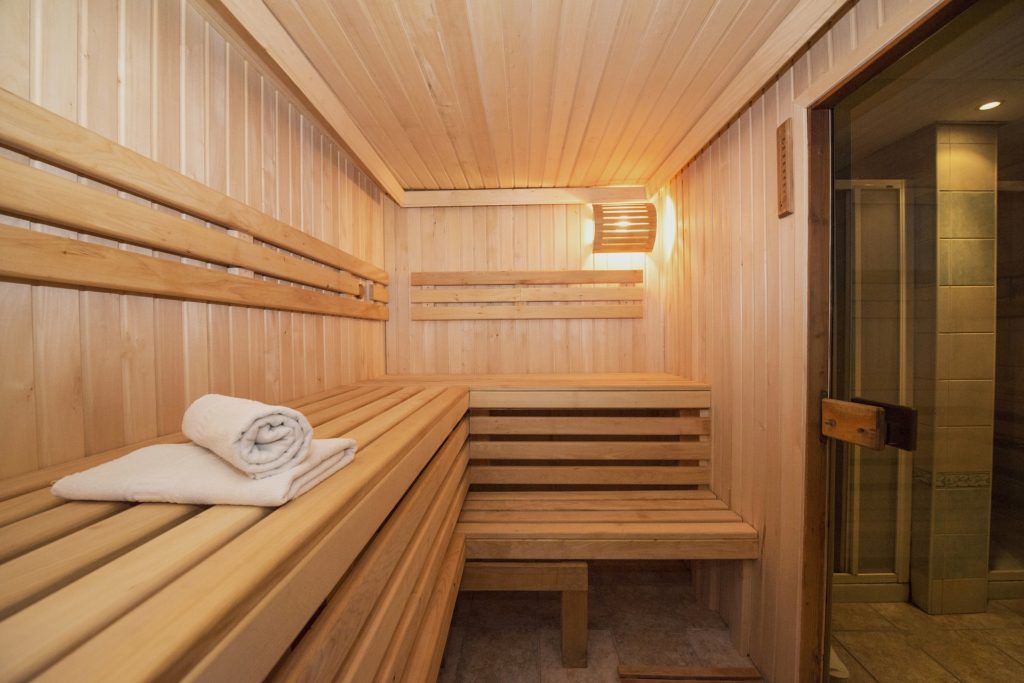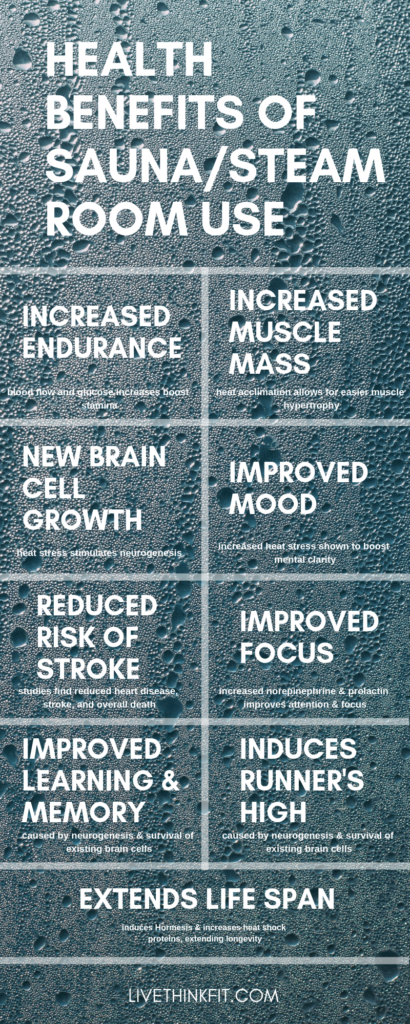Sweating is amazing for you.
Forced sweating or heat stressing is very good for you. No matter your preference, steam room vs sauna, both are great ways to do this. We’ll focus on the benefits of the sauna vs steam room.
Using either a sauna or a steam room is a form of heat stress or acclimation. The type of heat you are exposed to differs, and the health benefits of each vary to a degree.
Steam room vs sauna
A sauna is typically a wood paneled room with wooden benches and an electric heater that produces a dry heat. Some saunas have rocks on top of the heating unit that can be wetted – in order to produce more heat. Temperatures range from 160-210 degrees, and sometimes more.
Steam rooms produce a wet, humid heat – they run at 100% humidity. Rooms are usually tile, glass, or plastic, and are very wet – the floor and walls usually soaked, and the humidity is noticeable immediately on your skin. A steam boiler spits out boiling water that steams immediately and heats up the room. They don’t get as hot as saunas – typically ranging from 100-120 degrees.
Health benefits of heat stress
Stressing your body through exercise has enormous health benefits. But, that in conjunction with heat stress is an incredible combination that produces phenomenal health benefits. All of these results have been found as a result of sauna use, but regardless of which you use – steam room vs sauna – you will get these benefits to a degree.
(benefits of sauna vs steam room )
(Disclaimer: We are not medical professionals. Intentional heat stress, or use of sauna and/or a steam room is not suitable for all individuals. We are simply reporting the health benefits seen in healthy individuals who have been cleared for steam sauna room use. Please consult your doctor before using a sauna or steam room.)
Physiological benefits
Hyperthermic conditioning (or raising your body’s core temperature above resting temperature) has incredible benefits to the body. These can be broken down into two categories: physiological benefits and (cerebral) brain benefits.
Increased endurance
As your body heats up, your body increases blood flow to muscles, organs, and skin. This allows your body to work longer and harder.
How hyperthermic conditioning facilitate this increased endurance:
Increased glucose and fatty acid production. Often during endurance training or running, you will “hit a wall”. In biological terms, this is when your muscles have depleted its glycogen stores. Heat acclimation has been shown to reduce the need for glycogen stores by 40-50%, compared to not being heat acclimated. In other words, you can train 40-50% harder and longer before you’d normally hit a wall.
Blood flow to heart and muscles increases, reducing strain and lowering heart rate. That means that if you were to do the same cardiovascular workout with and without some sort of heat acclimation, doing it with heat acclimation would be considerably easier on your body despite it being the same workload.
Blood flow to the skin is increased, activating the sympathetic nervous system which allows sweating to occur at a lower core body temperature and to be maintained for a longer period, essentially allowing you to workout longer (increased endurance).
Norepinephrine is released, allowing heat to be dissipated more quickly, lowering core body temperature. Essentially, this allows you to workout longer, increasing endurance.
Reduced risk of stroke
Frequent sauna use has been shown to dramatically reduce the risk of stroke. In this long-term study of Finnish men and women, middle aged adults who frequented the sauna had a significantly less incidents of stroke than those who did not.
Easier acquisition of muscle mass(muscle hypertrophy).
Muscle hypertrophy is simply an increase in muscle mass. Basically, heat acclimation makes it easier for muscle hypertrophy to occur.
Muscle hypertrophy occurs through an increase in cell size which depends on increased protein synthesis.
Exercise is the most widely known inducer of muscular hypertrophy. But this process is a battle of opposing forces. Exercise increases protein synthesis, but also increases oxidative stress which causes degradation of the proteins we’d like to keep in order to increase muscle.
So, anything that can combat oxidative stress during exercise will result in a net increase in protein synthesis and thus hypertrophy. Enter heat stress.
Exercise (increased protein synthesis, increased oxidative stress) + heat stress (reduced oxidative stress) = more muscle hypertrophy (increased muscle mass) – OR –
Exercise + heat stress = More muscle mass > Exercise without heat stress
How does this work? Enter:
Heat Shock Proteins, Courtesy of the Sauna
Heat acclimation induces production of heat shock proteins which repair damaged proteins and reduce oxidative stress, thus creating a net increase in protein synthesis and hypertrophy.
Heat shock proteins are the key. By heat acclimating, your body will induce more heat shock proteins during later elevations in core body temperature – like physical exercise.
Essentially, heat stress will continue helping your body grow muscle in the future, including during and after exercise
Muscle Hypertrophy pt. 2
Growth hormone administration to performance athletes for 4 weeks showed a decrease in protein degradation by over 50%. Heat acclimation releases huge amounts of growth hormone.
Growth hormone (through heat stress) = more muscle mass
Heat acclimation releases growth hormone in the body. 2 back to back 20 minute sauna sessions at 80 degrees C boosts GH 2-fold. 2 1-hour sessions at 80 degrees C for a week increased GH 16 fold. Obviously, this is a bit extreme, but it goes to show that the effects of frequency of heat acclimation.
The greater amount of heat acclimation, the great amount of Growth Hormone (muscle mass)
Cognitive benefits
Your brain also benefits greatly from sauna use. If you’ve ever used a steam sauna before, you know that feeling of mental clarity post-use. It’s an extremely calming feeling that you get every time. There are many benefits in addition to improved mental state. Some of these benefits include:
Improve focus
Staying in a sauna until exhaustion has been shown to dramatically increase norepinephrine and prolactin. Norepinephrine is critical for focus and attention. Prolactin is important for myelination – boosts electrical activity in brain and repairs nerve damage. Heat acclimation boosts norepinephrine capacity for later use. This also has possible treatment implications for ADHD.
Improved learning and memory & increased brain cell growth
Heat stress increases neurogenesis (new brain cell growth), survival of existing brain cells, and improves learning and retention.
Induces runner’s high
That feeling dubbed “runner’s high” is a feeling of euphoria or high after a run is actually a release of endorphins. Heat acclimation can induce that same feeling.
So, dynorphins are the opposite of endorphins, and are responsible for feeling of dysphoria (opposite of euphoria). The feeling of discomfort you feel during exercise or heat stress is caused by dynorphin release. This release re-sensitizes you to the feel good effects of endorphins. Hyperthermia from sauna use increases dynorphin levels and subsequently endorphin levels more than exercise alone.
Longevity (Increased life span)
Heat stress induces hormesis which causes increased expression in genes and proteins including heat shock proteins, that increase longevity.
In a Finnish study, investigating the relationship between longevity and sauna/steam bath use, researchers found that the higher the frequency of sauna bathing, the lower the rates of fatal cardiovascular disease, sudden cardiac death, and all-cause mortality (death from any cause).
So, it has been been proven that frequent sauna use extends life expectancy. What more reason do you need to start heat stressing your body?
Steam room vs sauna conclusion: Lack of studies done on steam room
While we’ve mostly focused on sauna use in this article, some of the same effects are thought to be produced through steam room use. The reason for the focus on sauna over steam room, is that there is scientific evidence backing these results from sauna use. B
Leading researchers on the topic think that some of the same results can be reaped from steam room use, but to what degree is uncertain. It is believed that because the steam room doesn’t get as hot, the results will be less substantial. More research is needed, but it seems that the sauna is the preferred form of heat stress in the steam room vs sauna debate due to its higher temperatures.

Safety
Consult with a doctor to determine if you are healthy enough for sauna/steam use. Be responsible when heat stressing. Be sure to stay hydrated throughout the process regardless if you’re using steam room vs sauna.

